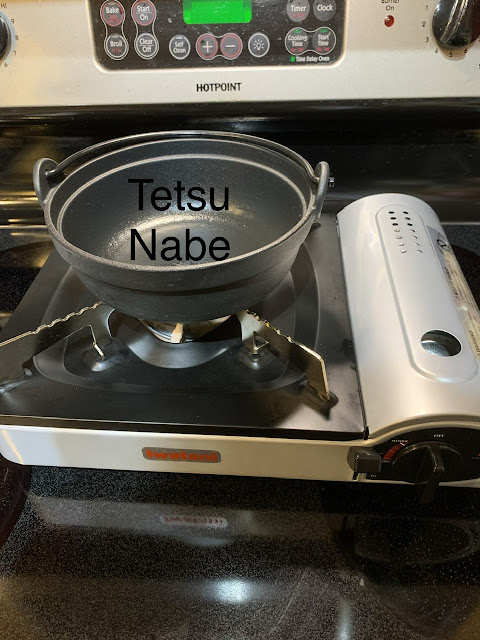So, why am I writing about this again? I want to show how my sukiyaki making has evolved over the last few months as I have learned more about the tradition. I will rush to note that nothing I learned about making this dish as a child was wrong and the results are the same level of deliciousness. The two main differences are 1) using more traditional Japanese ingredients and fewer substitutes and 2) using a traditional iron cooking pot. My mother didn’t have easy access to a specialty Asian / Japanese grocer as I do now, so I don’t blame her one bit. Also, my Dad would have never eaten tofu.
Here is where you can get yourself a tetsu nabe - a cast iron cooking pot. I have a 28 ounce one, which feeds me when I’m starving. If you were including other dishes, then that size would likely feed two.
Sauce
- 1 cup soy sauce
- 1 cup sake
- 1 cup aji-mirin
- 1/4 cup sugar
- 1/4 cup awase dashi
I make this sauce in double batches and keep it on hand. It’s never going to go bad, and I make this dish a couple times per month in the fall and winter, so it gets used up quickly.
You can buy instant dashi powder, but I prefer to make my own following the instructions by Nami Chen on JustOneCookbook.com How to make dashi
Ingredients
- 1 tablespoon neutral flavour oil
- 1 finely chopped shallot
- 1/2 pound beef cut for sukiyaki
- 3 scant pinches aji-no-moto (don’t believe the anti-Asian propaganda about MSG)
- 2 green onions
- 2 napa cabbage leaves
- 1/2 cup shirataki noodles (nearly 0 net carbs!)
- Shimeji and / or enoki mushrooms
- 2 stalks of celery
- braised tofu
- bean sprouts
Prepare your sauce and ingredients in advance. Use a culinary torch to braise the tofu.
Heat the oil in the iron pot and being to sauté the shallot. After a few minutes, add the beef to brown it. Sprinkle with aji-no-moto. When all the pink is gone, remove the pot from heat.
Pile the beef up in the center and arrange the other ingredients around it, leaving the bean sprouts out for now.
Add sauce until is it about a half inch from the lip of the pot. Return to heat and bring to a rolling bubble. Place the cedar lid on the pot and reduce heat to low. Simmer covered for 8 minutes.
Add the bean sprouts to the top and cover for an additional 2 minutes.
Serve immediately.with a spoon and chopsticks.
Photos
 |
| There is no substitute for the beef. You just have to find an asian grocer who prepares it. |
Cooking with Flame
I have grown attached to cooking with a flame, so I bought a Japanese butane burner unit like the ones used in every hotpot restaurant in the world. The accompanying instructions tell you to never use it indoors, but that is really just for insurance purposes. What you have to do is not use it in an enclosed space like a tent or camper and also not use it for extended periods of time. Butane burns much cleaner than propane, so as long as you have significant ventilation, you’re fine. The risk is that if you are in an enclosed space and the oxygen supply starts to get used up, then the butane flame will stop producing carbon dioxide, which you can handle, and start producing carbon monoxide which will kill you in minutes. I keep mine on top of my electric range with the hood vent running and do not have any concerns. Here is the model I have. It has the best safety rating.










No comments:
Post a Comment